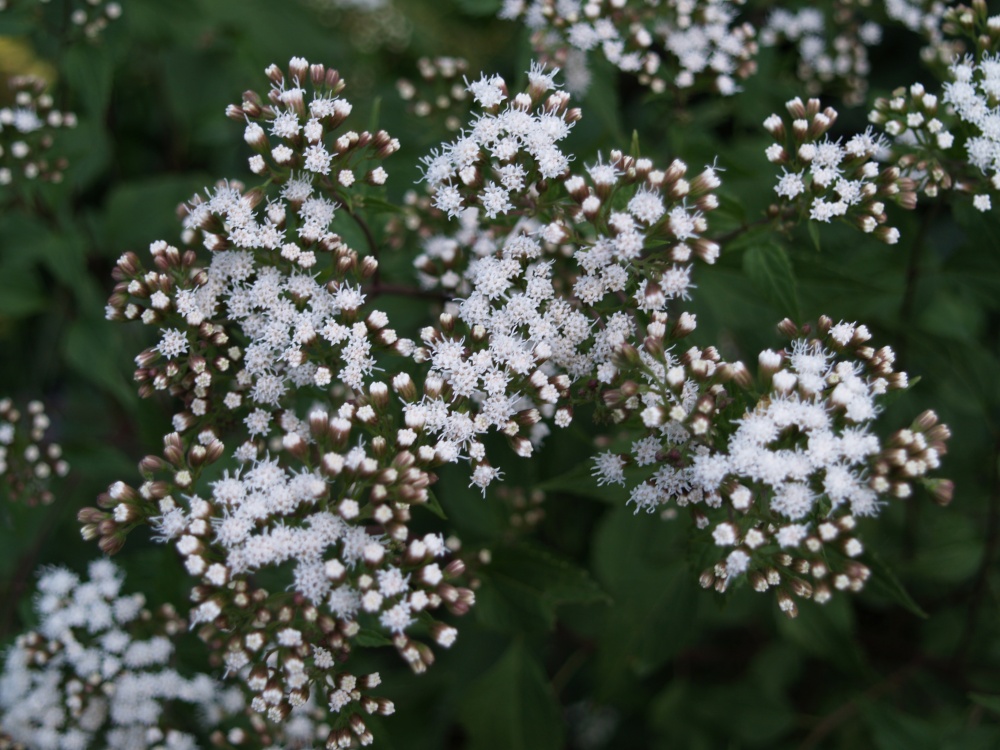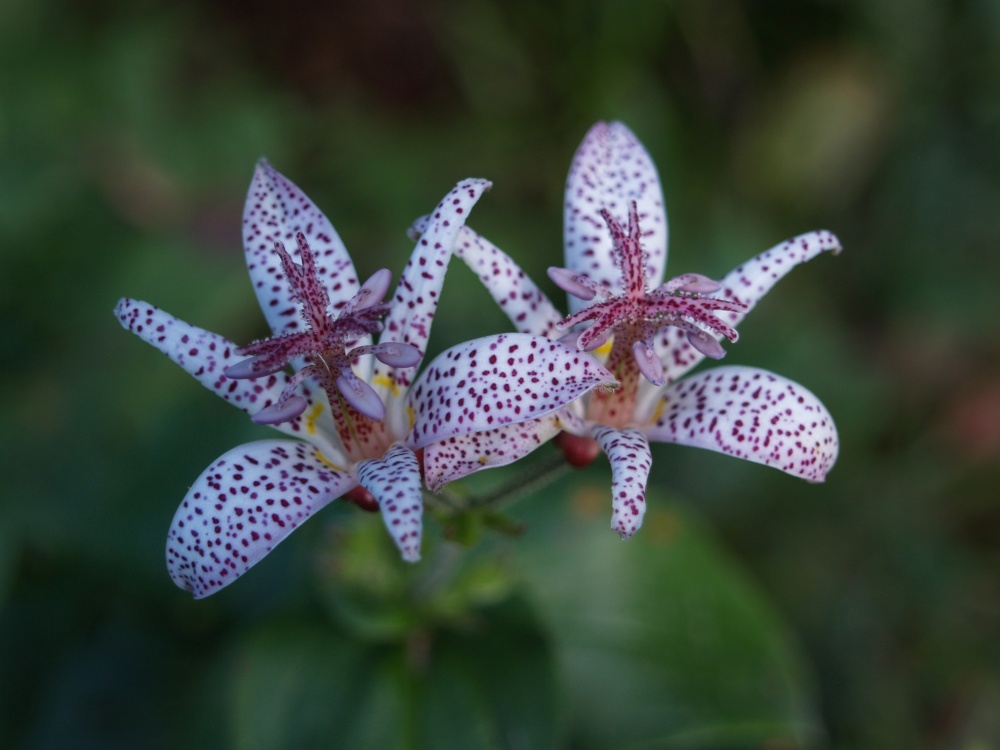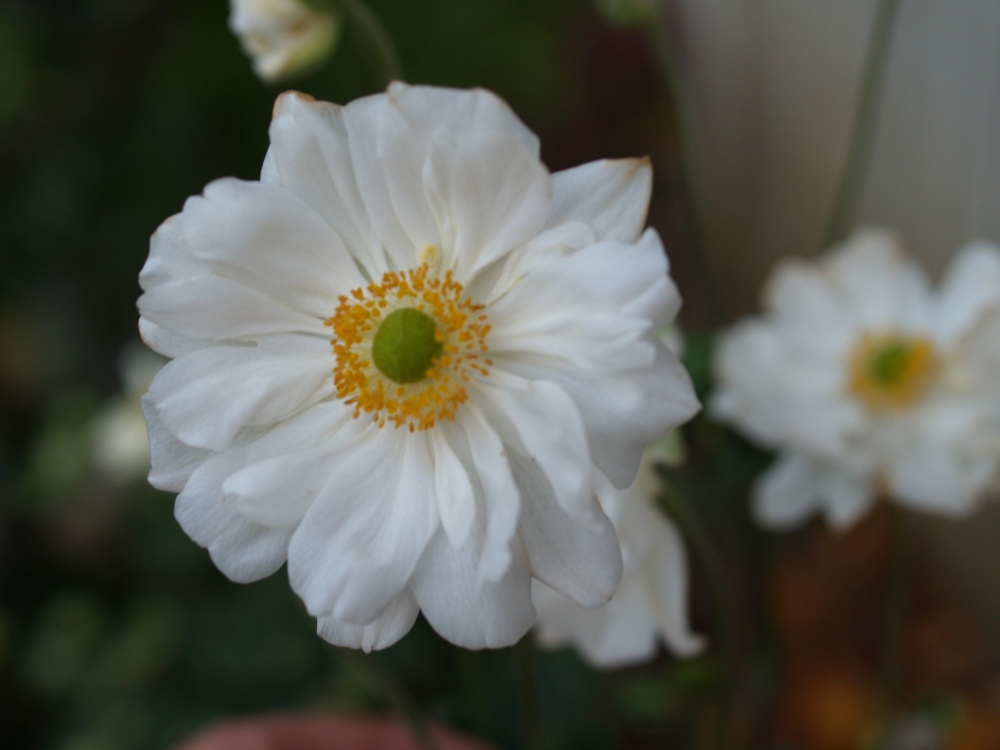As autumn begins and cooler temperatures arrive there are fewer blooms, and foliage shows signs of the imminent change to dormancy. With a relatively cool and wet summer, fewer plants have been stressed by heat, but several shrubs and trees have reacted to damper than usual conditions by dropping foliage early so that the garden’s appearance is very typical at the end of September. Several nights with temperatures in the upper thirties have triggered trees to begin their annual change in foliage color, though the change will not be evident for many trees until after the first frost (which cannot be far off).
The native Joe Pye weed (Eutrochium purpureum, above) passed out of bloom weeks ago, but now the related variety ‘Chocolate’ (Eutrochium rugosum ‘Chocolate’, below) is flowering. In fact, I don’t believe that the original plant of ‘Chocolate’ exists any longer, and who knows what could have happened to it since it is vigorous and sturdy, but the few seedlings that are scattered about the garden have lighter, greener foliage than ‘Chocolate’. The flowers are ample evidence that these are progeny of ‘Chocolate’, and it’s not unusual for seedlings to vary, as the ones in the garden do. At the corner of the garage several seedlings have massed together, and it’s only possible to discern that there are several plants because there are differing shades of dark green to just plain green foliage within the group.
There are fewer butterflies in the garden in early autumn, but neither butterflies or bees pay much attention to the flowers of the ‘Chocolate’ seedlings. Still, it is a pleasant enough plant, though not nearly as valued as the native Joe Pye. Currently, the bumblebees are busy with the speckled flowers of toad lilies (Tricyrtis, below), and with cooler weather all cultivars are now at peak bloom. If there is no severe drop in temperature (and hard frosts are rare in northwestern Virginia in October) these will remain flowering through the end of the month, with a few stragglers into November.
One toad lily was nibbled nearly to the ground when I missed it while spraying deer repellent in mid summer. This has happened before, and the toad lily will usually recover nicely and flower a few weeks later than others if the damage is done early enough. But, this one was eaten too recently, and I’m guessing that there will not be enough time before frost for it to set bud and bloom. There are twenty or thirty of various types of toad lilies in the garden, so the blooms of this one plant will hardly be missed.
Other than an occasional problem with deer when I overlook one when I’m spraying a repellent, toad lilies are sturdy perennials that are not very particular about being planted in nearly full sun or part shade. I’m guessing that they prefer a bit of shade, but a few that I’ve planted in more shade have stretched noticeably, while ones in more sun are more compact. For a gardener who is encouraged to try toad lilies I say, don’t worry about the variety. If one or another is not readily available, don’t worry, they’re all splendid plants and there is no reason to delay until a specific cultivar can be found. I have hopelessly jumbled mine so that I barely can recall which is which, but this isn’t really much of a problem since all are marvelous.
Gardeners are invited to plant Japanese windflowers (Anemone ‘Whirlwind’, above) as simple to grow and carefree, but this is another that bedevils me. I particularly favor the single, pink ‘September Charm’, but unfortunately it has disappeared along with the single, white ‘Honorine Jobert’. I’m quite certain that the ever expanding shade in the garden is the culprit, and undoubtedly nothing that I’ve done has caused such poor success. It seems that in only a part day’s sun windflowers will not work for any more than a year or two (at least for me), so I must resist planting in just any spot of open ground without regard to its sun exposure. No doubt this is a good rule to follow when planting anything, but it can be difficult to find space for so many treasures with the limited amount of sun in the garden.


Great Post!
In my garden (outside Boston) the Japanese anemones seem to thrive in part shade. One pink-flowering plant I put in 3 or 4 springs ago as a tiny thing is now a huge mound 4′ across and high, and this year it produced many dozens of flowers over a long period from late July to late September (there is still a flower or two left). I’ve moved several offsets to other parts of the garden and they also seem to be doing well. I’ve killed my share of plants so I know it’s not my gardening skills, this plant is just very vigorous here.
Japanese anemone is vigorous in this area also. I’ve seen gardens where no care is given at all, and it’s practically invasive. It’s confounding to me that I’m unable to grow a handful of plants that everyone else grows with ease, but I suspect I’m not the only one. Often, the difference in survival is a matter of fractions, so I don’t get too concerned when a plant fails. I try again, and if I fail more than two or three times I figure that this one won’t work for me.